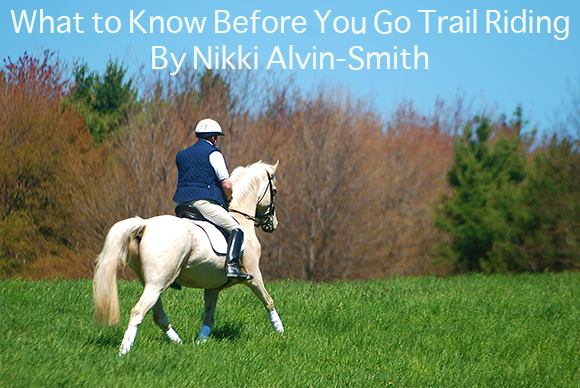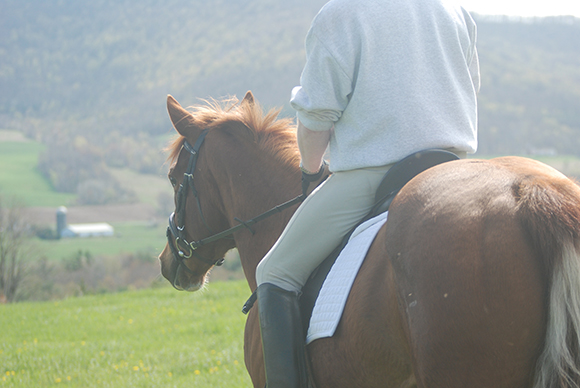What to Know Before You Go Trail Riding
By Nikki Alvin-Smith

Trail riding is tremendous fun and is a great way to keep your horse fresh and happy. As a competitive dressage rider and as a trainer I believe time spent out on the trail is just as almost as time spent working in the ring. This time out and about doesn’t just freshen your horse’s mind it freshens your mind too. The crisp Fall air after a frosty morning with the air full with an earthy scent; the sweet perfume of pine in the forest as you step over the needles on a sandy trail on a hot summer day; the sharp whip of the wind across your face as you canter across an open field; walking home after a good ride out with your horse in a relaxed walk accompanied by the smell of horse sweat and warm leather are all memories to be cherished. Aside from just enjoying the ride and communing with nature there are many exercises that you can include during your trail ride to aid your horse’s physical and mental development, to build stamina, muscle and his trust and confidence.
When training your horse to do anything it is important that you give him a fair understanding of what you expect from him and introduce him with kindness to the task. A trail horse needs to have good manners and you will need to overcome his fear and flight instincts before you just saddle up and go.
Your first consideration should be the tack and equipment you will use. During Fall months you will most likely be sharing the trail with hunters and they need to see you coming and not mistake you for a target. Riding apparel for the rider should in any event include a bright colored vest or jacket. This item is also beneficial if you find yourself on the road to give oncoming motorists notice of your presence. You can add a vivid colored saddle pad and reflective material if you expect to be out during dusk or dawn.
If you expect to be riding up and down steep and hilly territory then a crupper and breastplate may be needed to keep your saddle secure. If you are packing gear in saddlebags be sure to balance the weight evenly on each side of your horse.
The single most important piece of equipment is an ASTM certified riding helmet. And yes, they make Western varieties. Not only can this save you a concussion if you fall off, it protects you from being kicked by another horse, and from being hit in the head by errant branches which can be quite painful.
Your tack should be in good order, and your horse should be protected from cuts and scrapes with boots including bell boots if you expect to be in rocky terrain. You should also have your horse shod appropriately if he is to work on gravel or hard services.
You should carry a folding hoof pick and a basic first aid kit for horse and human and a lightweight poncho or rain protection of some sort for yourself. Depending on the climate and length of the ride you might also require water and some form of snack for sustenance. In bug season some form of protection for both your horse and yourself is needed and in hot weather a high rated SPF skin protection cream is a good idea.

Your horse needs to be appropriately prepared for the trail and some obstacle training at home is a great boost for his confidence. While the ‘how to’ of obstacle training is fodder for a whole other article, it is a good idea to know that your horse will cross water or ditches, go up and downhill, jump minor obstacles such as logs and brush. He should also be happy to go past both stationary and moving obstacles you might encounter and domestic animals and wildlife and be comfortable with loud and sudden noises.
The importance of good manners such as standing to be mounted and standing still at a halt whether alone or in company should also be practiced. It is easy to come off your horse or need to dismount and you will need your horse to stand peacefully so you are able to safely remount.
This may sound silly but your horse also needs to be well schooled to stop and to go. He must respond to your forward leg aid and command without question and respond to your commands to come down a gait and come to a full stop with compliance despite whatever might be going on in his environment.
When out on the trail if you find yourself on a narrow trail on a hill or cliff and need to turn your horse around always place his head to the outside of the edge when turning as this is how he will best know where his feet are placed. If it is particularly treacherous then dismount but follow the same protocol with his head to the outside of the ledge. If traversing steep banks of up to fifteen feet or less always try to go directly up and down if possible. This way if your horse slips he will not fall and pin your leg.
If your horse or you are green and new to trail riding always seek the companionship of an experienced trail horse and rider for your first outings. How the early days go will set the tone for the rest of your horse’s life.
Before you set off on a trail ride you should also consider the safety of riding alone versus in company even if you consider yourself and your horse experienced trail riders. While it is common sense to have your cell phone with you and some form of I.D. in case of an accident and to let others know where you are going and when you expect to be home, it is also much safer to ride in company than alone. Horses as herd animals find comfort in the company of another equine given that companion is also a well-mannered horse. Added bonus, you have someone with whom to chat and with whom to share the wonderful trail experience.
It is always a good idea to check the weather forecast before setting off as thunderstorms and lightening can be terrifying for your horse and dangerous if you are out in the open. Fog/rain and sleet/snowy weather can lead you down the wrong path and you do not want to become lost. For this reason it is also wise to stay to groomed or worn trails wherever possible.
Resist the urge to take your dog with you. Your dog may be perfectly obedient generally but can quickly become distracted and run off, become entangled in your horse’s legs during a spook or bolt, become tired and thirsty or can be attacked on the trail by other dogs.
When you make a stop during the trail ride be careful to watch what your horse grazes and be aware of noxious weeds. Also beware of unknown depths in bodies of water, do not traverse water where the current is high as you have no way of knowing the power of the current.
If you are going to tie your horse on the trail then bring along a rope to tie him, do not use the reins.
Hitting the Trail in A Group
Before you consider taking part in a group event be certain you can control your horse at all times. A group setting will involve riders of all abilities but it is your responsibility to know that you and your horse are not a liability to others.
You should also follow certain etiquette as a member of a group both for the safety of yourself, your horse and others.
When riding in a group the variety of experience of both the riders and the horses may be huge. All members of the group need to be cognizant of the level of riding ability of those around and in larger groups it is a good idea to split the ride between experienced riders who may prefer a quicker paced ride and those that are less confident. However the less confident group should always have an experienced trail horse/rider combination at the front to lead and one to bring along the rear and to see no-one is left behind.
We all know horses can kick and startle. It is important you leave a minimum of a horse’s length between you and the rider in front of you. If you decide to overtake you must give that rider a ‘heads up’ comment and do not overtake them at more than a walk because even an educated horse can become excited if someone canters past them or rushes past at a trot. Allow plenty of room when passing and pay attention to the reaction of the horse you are passing. If he pins ears, rushes or looks concerned then back off and wait until a better opportunity presents itself such as at a check.
When you are headed home on the trail many horses will become distracted and excited. If you have trained your horse correctly you will not have allowed him to decide when to change his gait or pace but will have directed him throughout the trail ride maintaining command and control. If on the way home he becomes excited you can flex his head to the side to keep your leg active or you can make small circles periodically. Do not allow your horse to push into horses in front of him.
When you are out on the trail you should always respect the property on which you travel by not trespassing, not galloping past pastured horses, and not leaving garbage in your wake. It is also important to show respect to other trail users that may be intimidated by horses by halting and allowing them to walk past you and allow them plenty of room to do so.
Trail riding can be great fun for all involved. Remember that trails take maintenance. With the budget limits for municipalities and State Parks the responsibility to keep trail systems open often falls to volunteer help. So if you ride the trails, think about helping with the brush clearing and Spring tidy up.
Happy riding.


